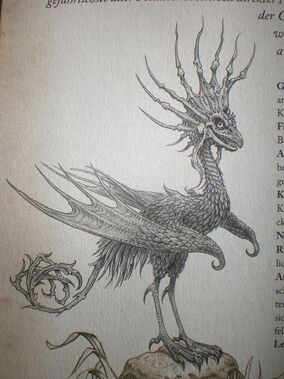| Cockatrice | |
| Genus: | Gallicus |
| Species: | halitosis |
|
Subspecies: |
None |
|
Infraspecies: |
None |
| Coloration: | Red or green |
| Range: | Mediterranean regions of Europe, Asia, and Africa |
The pusedo-dragon known as the Cockatrice(Gallicus Halitosis.) is thought to be a distant relative of the Dragons and Phoenix. Due to its venom and appetite the Cockatrice is the most dangerous pusedo-dragon. Sometimes, the Cockatrice form is chosen by the Basilisk,making identification(And hopefully escape.) difficult.

cockatrice(Gallicus Halitosis)
Description.[]
They are 1 to 2 feet high and 3 feet long. The colouration is red or green with a yellow-orange underbelly. Cockatrices have scales on the face and neck, feathers on the body, leathery wings and a crest of long spines. Their call has been charitably compared to a Banshee. They will eat anything that moves, except for snakes and toads which it uses to incubate its gold-coloured eggs. They attack with their poisonous breath, although their beak can inflict a deadly wound as it contains rows of sharp teeth. Cockatrices ambush from under mounds of pine cones, gathered for that purpose. They build their nests in pine trees and the occasional confusion of ships with pine trees has lead to it spreading out across the world. Their foul breath can be bottle with the aid of a trained weasel before being bubbled through springwater. It can then be thrown to stun dangerous monsters without causing any lasting damage. Contrary to what popular myths say, cockatrices do not have a petrifying or venomous glance.
Range.[]
Mostly found in the Mediterranean mountain forests, although the famous Bogcrow inhabits a swamp in South Wales and some have been sighted as far afield as Newfoundland Canada.

A large tame toad will be required in order to help your baby cockatrice to hatch out properly.